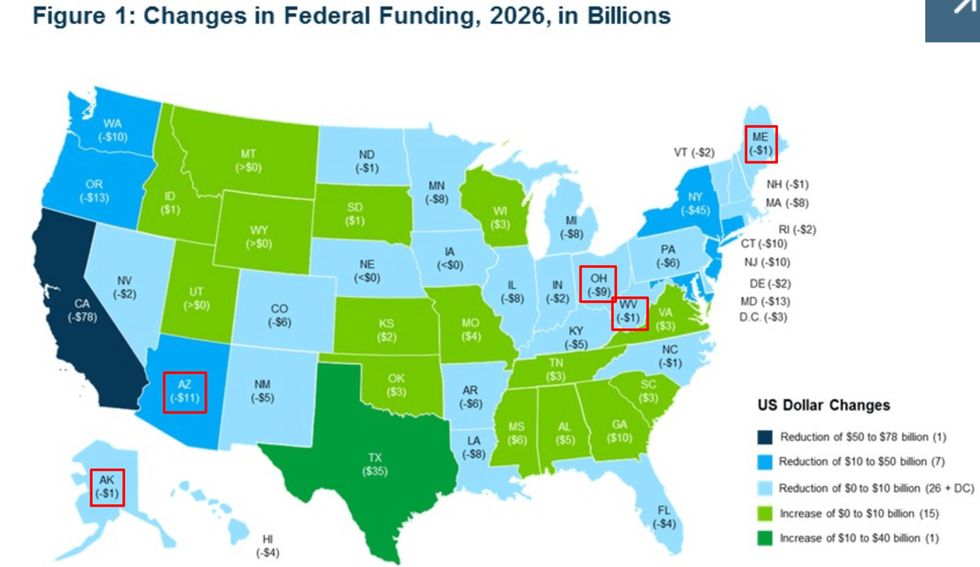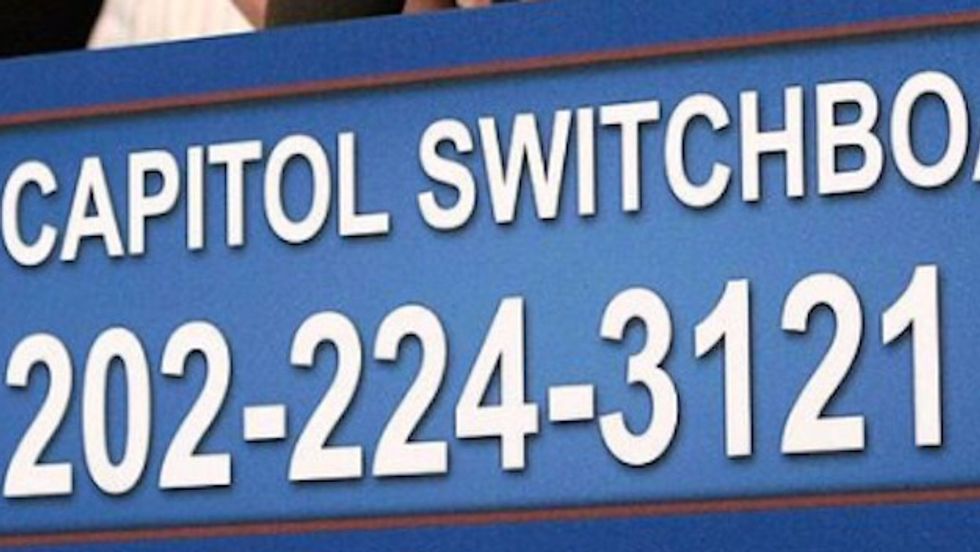ISenate Republicans are stumbling forward with their new zombie Trumpcare bill to repeal Obamacare — and they will hold a vote this month, before the nonpartisan Congressional Budget Office tells them how many people might be tossed off of coverage if it becomes law. The drawback of this — or is it a benefit, given that the public is also being kept in the dark? — is that Republicans will vote on the bill without knowing all that much about how it would impact their own states, not to mention the rest of the country.
Unfortunately for the bill's supporters, a new study just came out that will enable Republicans to make a somewhat more informed decision about this legislation, after all. And it could deal a blow to the bill's chances. It should, anyway.
The study, which was released this morning by Avalere Health, a consulting firm, finds that many states will see sizable cuts to the federal money that would flow to their states, relative to current law. Some of those states are represented by the GOP senators who are currently deciding whether to back the bill, including Lisa Murkowski (Alaska), Susan Collins (Maine), Rob Portman (Ohio) and John McCain (Ariz.).
Here's a chart from the study that demonstrates how the bill — which is being championed by Sens. Bill Cassidy (R-La.) and Lindsey O. Graham (R-S.C.) — would impact the federal funding to states. Because of the bill's complex funding formula, some states gain, relative to what spending would be under current law (the Affordable Care Act), and others lose. The blue ones are the losers.
Graham-Cassidy kills the ACA's Medicaid expansion and subsidies for lower-income enrollees on the exchanges, starting in 2020, and replaces them with block grants to the states, which can then spend the money on coverage in other ways, or on other things entirely. (After 2026, the block grants end.) The bill's proponents claim that the states will merely gain flexibility under it.
But as the new study shows, because of the bill's funding formula, a lot of states will end up with substantially less federal money to spend on health-care coverage than they would have under current law. In the period from 2020 to 2026, overall the bill will mean a $215 billion cut to federal spending. Here's how that cut will impact individual states:
• Arizona would get $11 billion less. McCain, who was one of the three senators who sank "skinny repeal," has said he may oppose the bill because he is unhappy with the lack of regular order, but on top of that, we now learn his state would take a hit, too.
• Alaska would get $1 billion less. Murkowski has emerged as a key swing vote — she also helped sink "skinny repeal" and has opposed deep Medicaid cuts. She has said she wants to learn more about how the new bill would impact her state. Now she knows. "Alaska might seem like a big state geographically, but it's actually a small state in terms of health spending, so a $1 billion reduction is a massive cut," Topher Spiro, a health policy analyst at the Center for American Progress, told me today.
• Ohio would get $9 billion less. Portman is in a weird spot, because Ohio Gov. John Kasich has been scaldingly critical of the bill, and now it looks as though it would really wallop his state.
• Maine would get $1 billion less. Collins, who also helped sink skinny repeal, is said to be leaning against Graham-Cassidy, and now this should help cement her opposition. Spiro adds that Maine is also a state with low health spending, making this a big cut.
• West Virginia would get $1 billion less. Sen. Shelley Moore Capito (R-W.Va.) has repeatedly criticized in sharp moral terms the damage that the previous repeal bill's deep Medicaid cuts would inflict on her constituents.
Rand Paul, who is thought to be a hard "no," has previously criticized the bill for redistributing money among states. This study illustrates in graphic new detail just how bad this would be. As Elizabeth Carpenter, a senior vice president at Avalere, put it:
"The largest impact of the proposed bill would be the reallocation of federal dollars between states. Medicaid expansion states and states that have enrolled a high number of people in insurance affordability programs would be most adversely impacted."
And a lot of Republican senators represent such states. Colorado (Cory Gardner) would lose $6 billion. Pennsylvania (Pat Toomey) would also lose $6 billion. Florida (Marco Rubio) would lose $4 billion.
Here's another key point: The cuts get substantially worse after 2026, when the block grants run out. According to the Avalere study, if you factor in the total cuts under Graham-Cassidy from 2020 to 2036 — including 10 years after the block grants expire — that means a $14 billion cut to Alaska; a $133 billion cut to Arizona; a $161 billion cut to Ohio; a $17 billion cut to Maine; and a $27 billion cut to West Virginia.
In other words, the bill also creates a massive fiscal cliff for many states who stand to take an enormous wallop after 2026. The bill's proponents say Congress will reauthorize the spending at that point. But states cannot count on that, and they will have to plan accordingly, making it extremely challenging to design programs, even with additional "flexibility." The bottom line: GOP senators who vote for Graham-Cassidy will be voting not just to slash funding to their own states in the short term; but also possibly to put them in a seriously damaging long term bind.
Greg Sargent wrote this on September 20, 2017 in The Washington Post.
###
September 22, 2017
Addendum. The only estimate of the number of Americans that does exist is from the Commonwealth Fund, which on Wednesday released an analysis of the GCHJ plan by using previous CBO scores for similar bills and other studies.
Here are the major findings from Commonwealth's Sara Collins:
- 15-18 million more uninsured in 2019: The bill's repeal of the individual mandate, which compels people to sign up for insurance, would have immediate effects when it goes into place in 2019. Based on previous CBO scores of similar provisions, the jump in the number of people without insurance compared to the current system would be as high as 18 million in the first year.
- 32 million more people uninsured after 2026: The bill also would shift funding for Obamacare's Medicaid expansion and individual insurance market subsidies into a lump sum given to states every year. The bill, however, simply cuts off those grants after 2026. Commonwealth said the roughly 32 million people projected to be beneficiaries of these programs would simply be cut off after that date.
- Significantly higher premiums: Commonwealth also said previous CBO breakdowns of a mandate repeal showed premiums increases of 15% to 20% in the first year. "The majority of that increase would come from the repeal of the mandate penalties: insurers would expect that those who remained in the pool would be the least healthy," Collins wrote.
- Undercut protections for people with preexisting conditions:States could apply for waivers to relax some of Obamacare's regulations if it brings down costs. While the bill does say the state has to continue to provide "adequate and affordable" coverage for people with preexisting conditions, Commonwealth said the leeway for the waivers could lead to the elimination of Obamacare's protections for these people. "It would allow states to apply for waivers that would let insurers charge people with health problems higher premiums, and change other ACA consumer protections such as bans on lifetime benefit limits and comprehensive coverage requirements," Commonwealth said.
Call your Senators. We have to stop Cassidy-Graham. Act as if lives depend upon this. They do



